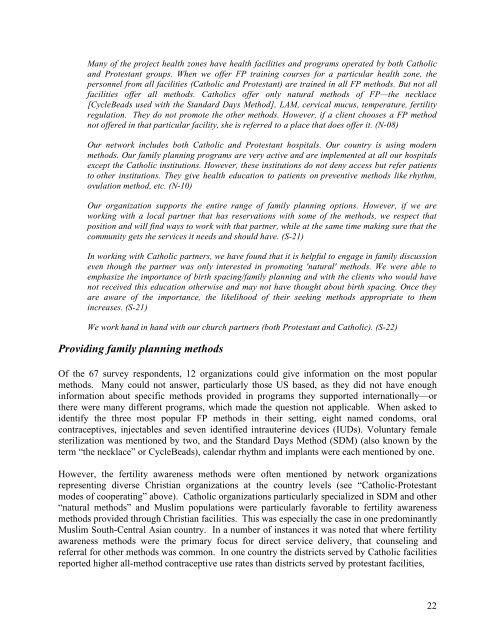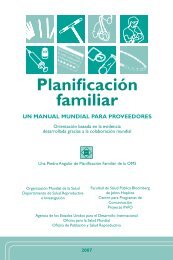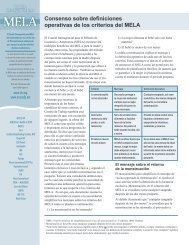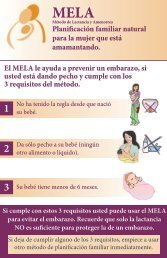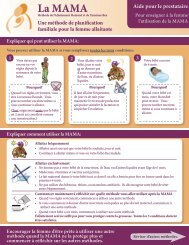International Family Planning: Christian Actions and Attitudes
International Family Planning: Christian Actions and Attitudes
International Family Planning: Christian Actions and Attitudes
- No tags were found...
Create successful ePaper yourself
Turn your PDF publications into a flip-book with our unique Google optimized e-Paper software.
Many of the project health zones have health facilities <strong>and</strong> programs operated by both Catholic<br />
<strong>and</strong> Protestant groups. When we offer FP training courses for a particular health zone, the<br />
personnel from all facilities (Catholic <strong>and</strong> Protestant) are trained in all FP methods. But not all<br />
facilities offer all methods. Catholics offer only natural methods of FP—the necklace<br />
[CycleBeads used with the St<strong>and</strong>ard Days Method], LAM, cervical mucus, temperature, fertility<br />
regulation. They do not promote the other methods. However, if a client chooses a FP method<br />
not offered in that particular facility, she is referred to a place that does offer it. (N-08)<br />
Our network includes both Catholic <strong>and</strong> Protestant hospitals. Our country is using modern<br />
methods. Our family planning programs are very active <strong>and</strong> are implemented at all our hospitals<br />
except the Catholic institutions. However, these institutions do not deny access but refer patients<br />
to other institutions. They give health education to patients on preventive methods like rhythm,<br />
ovulation method, etc. (N-10)<br />
Our organization supports the entire range of family planning options. However, if we are<br />
working with a local partner that has reservations with some of the methods, we respect that<br />
position <strong>and</strong> will find ways to work with that partner, while at the same time making sure that the<br />
community gets the services it needs <strong>and</strong> should have. (S-21)<br />
In working with Catholic partners, we have found that it is helpful to engage in family discussion<br />
even though the partner was only interested in promoting 'natural' methods. We were able to<br />
emphasize the importance of birth spacing/family planning <strong>and</strong> with the clients who would have<br />
not received this education otherwise <strong>and</strong> may not have thought about birth spacing. Once they<br />
are aware of the importance, the likelihood of their seeking methods appropriate to them<br />
increases. (S-21)<br />
We work h<strong>and</strong> in h<strong>and</strong> with our church partners (both Protestant <strong>and</strong> Catholic). (S-22)<br />
Providing family planning methods<br />
Of the 67 survey respondents, 12 organizations could give information on the most popular<br />
methods. Many could not answer, particularly those US based, as they did not have enough<br />
information about specific methods provided in programs they supported internationally—or<br />
there were many different programs, which made the question not applicable. When asked to<br />
identify the three most popular FP methods in their setting, eight named condoms, oral<br />
contraceptives, injectables <strong>and</strong> seven identified intrauterine devices (IUDs). Voluntary female<br />
sterilization was mentioned by two, <strong>and</strong> the St<strong>and</strong>ard Days Method (SDM) (also known by the<br />
term “the necklace” or CycleBeads), calendar rhythm <strong>and</strong> implants were each mentioned by one.<br />
However, the fertility awareness methods were often mentioned by network organizations<br />
representing diverse <strong>Christian</strong> organizations at the country levels (see “Catholic-Protestant<br />
modes of cooperating” above). Catholic organizations particularly specialized in SDM <strong>and</strong> other<br />
“natural methods” <strong>and</strong> Muslim populations were particularly favorable to fertility awareness<br />
methods provided through <strong>Christian</strong> facilities. This was especially the case in one predominantly<br />
Muslim South-Central Asian country. In a number of instances it was noted that where fertility<br />
awareness methods were the primary focus for direct service delivery, that counseling <strong>and</strong><br />
referral for other methods was common. In one country the districts served by Catholic facilities<br />
reported higher all-method contraceptive use rates than districts served by protestant facilities,<br />
22


